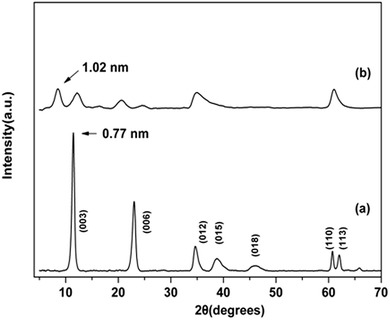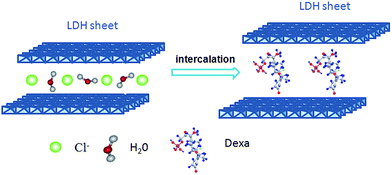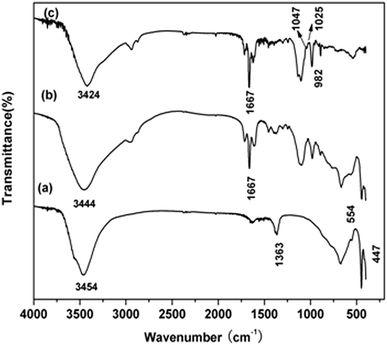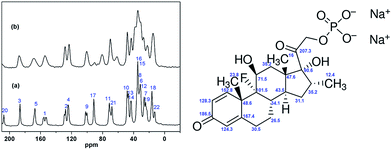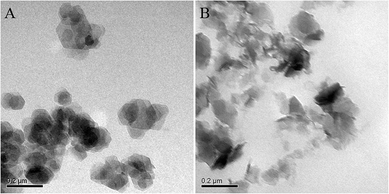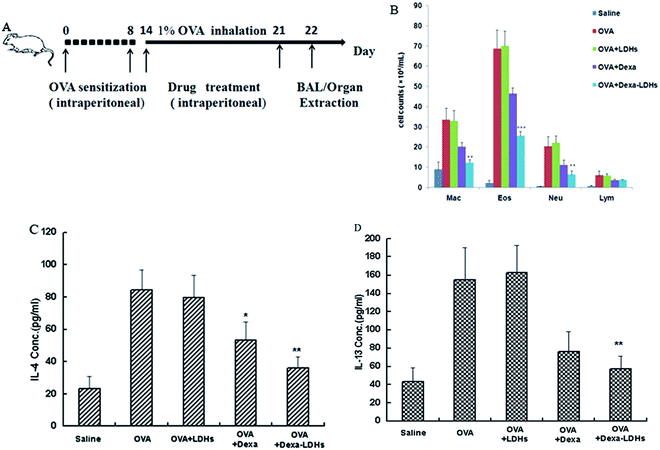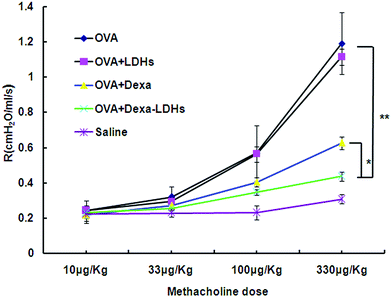Dexamethasone sodium phosphate intercalated layered double hydroxides and their therapeutic efficacy in a murine asthma model†
Wen-Rui Wang‡
a,
Ang Li‡a,
Wei Meia,
Rong-Rong Zhua,
Kun Lia,
Xiao-Yu Suna,
Ye-Chang Qian*b and
Shi-Long Wang*a
aResearch Center for Translational Medicine at East Hospital, School of Life Science and Technology, Tongji University, Shanghai, PR China. E-mail: wsl@tongji.edu.cn
bDepartment of Respiratory Medicine, Shanghai Baoshan Central Hospital, Shanghai, PR China. E-mail: qianyechang@163.com
First published on 19th February 2015
Abstract
Although inhaled steroids are the first choice to control asthma, frequent corticosteroid administration is associated with many side effects such as adrenocortical suppression, Cushing's syndrome and osteoporosis. The purpose of this study was to develop a drug delivery system to overcome the limitation of corticosteroid administration and improve the therapeutic efficacy in an ovalbumin (OVA)-induced allergic asthma rat model. The intercalation of dexamethasone sodium phosphate (Dexa) into layered double hydroxides (LDHs) was achieved by the co-precipitation method and the obtained nanoparticles (Dexa–LDHs) have an average diameter of approximately 100 nm. The X-ray diffraction patterns and FT-IR spectra of the Dexa–LDHs indicated that the Dexa molecules were successfully intercalated into the LDHs via electrostatic interactions. 13C NMR chemical shifts were analysed to clarify the characteristic changes in functional groups after intercalation. Elemental C/H/N and inductively coupled plasma (ICP) analysis revealed the compositions of the nanohybrids. The thermal stability of Dexa anions was enhanced by holding together within the LDHs layers. The drug loading was estimated to be 50.8% and a gradual and biphasic in vitro release behavior of the drugs from LDHs in pH = 7.4 phosphate buffered saline (PBS) was observed. The parabolic diffusion model was used to simulate the release kinetics of Dexa from the LDHs. The potential of Dexa–LDHs as an anti-asthmatic agent was evaluated in the allergic asthma rat model. The results showed that Dexa–LDHs were more effective than Dexa to reduce the number of inflammatory cells in bronchoalveolar lavage (BAL) fluid. Furthermore, Dexa–LDHs significantly inhibited the increase of T-helper-2-type cytokines such as IL-4 and IL-13, and more effectively suppressed airway hyperresponsiveness. In conclusion, these results suggest that Dexa–LDHs could enhance the anti-asthmatic effect of Dexa in the treatment of allergic asthma rats. Our work indicated that LDHs could be a promising candidate for the exploration of new Dexa formulations.
1 Introduction
Asthma is now one of the world's most common chronic inflammatory diseases, characterized by increased infiltration of leukocytes, especially eosinophils, into the airways, and reduced respiratory function.1 It is estimated that approximately 300 million people suffer from asthma worldwide and the number could further increase by 100 million by 2025.2 Currently dexamethasone, either inhaled or systemically delivered, is the most effective anti-inflammatory drug in the treatment of asthma, and is widely recommended as the first-line therapy for this disease. Regular use of dexamethasone has been shown to significantly reduce the mortality and morbidity of asthma sufferers.3 Dexamethasone inhibited the proliferation of smooth muscle, reduced airway hyperresponsiveness and prevented structural remodeling in airways.4,5 However, long-term use as well as high and frequent administration may generate severe side effects such as an immunological suppression, Cushing's syndrome and osteoporosis.6–8 In order to minimize the exposure of the whole body to the high concentrations of drug needed to obtain an appropriate concentration and to avoid the side effects of chronic use, local and sustained delivery of dexamethasone sodium phosphate is highly desired.In recent years, layered double hydroxides (LDHs) have received increasing interest worldwide in the field of drug delivery due to their low toxicity, biocompatibility, high stability, pH dependent solubility and enhanced cellular uptake behavior.9–11 Most LDHs minerals can be represented by the general formula [M1−x2+Mx3+(OH)2]x+ (An−)x/n·mH2O, where M2+ and M3+ are di- and tri-valent metal ions, respectively, An− is an exchangeable anion in the interlayer space, m is the number of molecules in the LDHs interlayer.12–14 Structurally, LDHs consist of hydroxide layers containing M2+ and M3+. Partial replacement of M2+ by M3+gives the hydroxide layer a positive charge, which is balanced by An− between the layers.15,16 Because the composition of LDHs is tunable, especially its exchangeable anions, a series of pharmaceutically active compounds, such as DNA, anti-inflammatory, antibiotic, antihypertensive, anticancer drugs, can be intercalated into the LDHs galleries.17–20 LDHs have been proposed for the controlled release of intercalated drugs because it has been reported that the intercalation of drugs can not only increase their solubility and improve their therapeutic profile, but also help to decrease its pristine harmful capacity.21 Moreover, the ability of LDHs nanoparticles to regulate immune response has also been found in our previous study.22 Therefore, it is a good choice to combine dexamethasone sodium phosphate (Dexa) with LDHs. The objective of this study is to minimize these side effects by encapsulating Dexa using layered double hydroxides, to extend the release time from nanoparticles and to evaluate the effectiveness in the treatment of asthma.
In the present work, dexamethasone sodium phosphate (Dexa) was intercalated into the galleries of MgAl–LDHs with coprecipitation method. Subsequently, the physicochemical property of Dexa–LDHs was characterized by powder X-ray diffraction (XRD), Fourier transform infrared spectroscopy (FTIR), nuclear magnetic resonance (NMR) 13C CP-MAS, thermogravimetric analysis (TGA) and transmission electron micrographs (TEM). The sustained release behavior of Dexa–LDHs was also studied. Furthermore, Dexa–LDHs were intraperitoneally injected into allergic asthma rats which were induced by OVA (ovalbumin) plus aluminum hydroxide (Alum). The effects of Dexa–LDHs on the cellular infiltration in bronchoalveolar lavage (BAL) fluid, the expression of inflammatory cytokines, and the histopathology of lung tissues were studied to determine their anti-asthmatic activity.
2 Materials and methods
2.1 Materials and animals
Dexamethasone sodium phosphate (Dexa) was a kind gift from the Tianjin Tianyao Pharma. Co. Ltd., China. MgCl2·6H2O (99%), AlCl3·6H2O (99%) and NaOH pellets (99%) were purchased from Sinopharm Chemical Reagent Co. Ltd (Shanghai, China). Deionized water (ddH2O) from which carbon dioxide was removed by boiling under nitrogen was used in all preparations. All other reagents were of analytical grade and were used as received without further purification (Fig. 1).Specific-pathogen-free, male Sprague-Dawley (SD) rats (4 weeks old, 110–130 g) were purchased from SLAC Laboratory Animal Ltd. (Shanghai, China). They were kept in an environmentally controlled room (temperature 25 ± 2 °C, 12 h light/dark cycle) for one week prior to experiments. They were housed under standard humane conditions and had access to food and water ad libitum. All animal procedures were performed according to the protocol approved by the Tongji University Institute of Laboratory Animal Resources.
2.2 Preparation of LDHs nanoparticles and Dexa–LDHs
Mg2.4Al–Cl–LDHs (pristine LDHs) were prepared using a co-precipitation method reported previously.23 Briefly, 10 mL of a mixed salt solution containing 0.3 M MgCl2·6H2O and 0.1 M AlCl3·6H2O LDHs was quickly added to 40 mL of 0.17 M NaOH under vigorously mixing at room temperature for 10 min in a sealed conical flasks. The obtained slurry was separated and washed twice via centrifugation, and then redispersed in 40 mL of ddH2O before hydrothermal treatment in a 50 mL autoclave at 100 °C for 16 h. The MgAl–Cl–LDHs were collected via high speed centrifugation and dried at 50 °C for 48 h for characterization.To make Dexa–LDHs, a mixed solution (40 mL) containing 0.17 M NaOH and 25 mM dexamethasone sodium phosphate was preheated at 60 °C for 10 min under nitrogen atmosphere, and then a solution (10 mL) containing 0.3 M MgCl2·6H2O and 0.1 M AlCl3·6H2O LDHs was quickly added. The mixture was vigorously stirred at 80 °C for 3 h under nitrogen atmosphere. Samples were then processed as outlined in synthesis of MgAl–Cl–LDHs section, including separation, wash, and hydrothermal treatment.
2.3 Characterization
Powder X-ray diffraction (XRD) pattern were recorded on a Rigaku Diffractometer Model Miniflex using CuKa source (λ = 1.54060 Å) at 40 mA and 40 kV. Fourier transform infrared spectra (FT-IR) were obtained on a Bruker Vector22 spectrophotometer using KBr pellet method (sample/KBr = 1/100) in the range of 4000–500 cm−1. 13C MAS NMR spectra were obtained at a frequency of 75.0 MHz using Bruker AVANCE AV 400 superconducting nuclear magnetic resonance spectrometer (H0 = 7.05 T) and 4 mm chemagnetics MAS probe. Transmission electron micrograph (TEM) samples were obtained using a JEOL 1230 Transmission Electron Microscope at an acceleration voltage of 200 kV. Thermogravimetric/differential scanning calorimetry (TG-DSC) was measured on a STA-449C (Netzsch Co. Germany) machine with a heating rate of 20 °C min−1 in N2 atmosphere. The compositions of the nanohybrids were determined by elemental C/H/N analysis of Vario EL III (Elementar Co. German) and inductive coupled plasma (ICP) analysis of J-A1100 (Jarrell-Ash Co. USA).2.4 Determination of loading amount and in vitro release test
The amount of intercalated dexamethasone sodium phosphate was determined by UV-Vis spectroscopy. A known weight of nanohybrids was placed in a 10 mL flask to which 0.5 mL of 5 M HCl solution was subsequently added. Then the flask was filled with 0.02 M phosphate buffer solution. After the hybrids were totally dissolved, the concentration of dexamethasone sodium phosphate was determined by monitoring the absorbance at 242 nm with a UV-Vis spectroscopy. The concentration was calculated according to the obtained standard curve of dexamethasone sodium phosphate (A = 0.02678C + 0.00973, r = 0.99946).The Dexa release test was performed in 200 mL of pH 7.4 phosphate buffer solution (0.02 M) containing 0.02 g Dexa–LDHs at constant temperature 37 ± 1 °C. The paddle rotation speed was 100 rpm. Aliquots (2 mL) were withdrawn at desired time intervals and filtered through a 0.45 μm syringe filter. The accumulated amount of Dexa released was determined by UV absorption at 242 nm. Four dissolution–diffusion kinetic models were used to fit the in vitro Dexa–LDHs release profiles.24 The zero- and first-order model are normally used to describe the dissolution phenomena, while the parabolic diffusion model expresses the diffusion-controlled release process and the modified freundlich model elucidates the diffusion behavior via ion-exchange.
2.5 A murine asthma model
Female rats were randomly divided into five groups (n = 8) and received the following treatments separately: (1) sham sensitization plus challenge with saline (nebulization); (2) sensitization with OVA via an intraperitoneal (ip) injection plus challenge with OVA via nebulization (Neb); (3) sensitization with OVA (ip) plus challenge with OVA (Neb) and Dexa (ip); (4) sensitization with OVA (ip) plus challenge with OVA (Neb) and Dexa–LDHs (ip) and (5) sensitization with OVA (ip) plus challenge with OVA (Neb) and LDHs (ip). On days 0 and 14, each rat was sensitized intraperitoneally with 1 mg ovalbumin (Sigma-Aldrich, St Louis, MO) and 10 mg aluminum hydroxide (Sigma-Aldrich, St Louis, MO) dissolved in 1 mL saline. On days 14–21, the rats were intraperitoneally injected with Dexa, LDHs, and Dexa–LDHs nanoparticles with the dose of 0.25 mg kg−1 based on the Dexa amount. 0.5 h later, rats were challenged with 1% OVA aerosol generated using an ultrasonic nebulizer (PariNeb Pro Nebulizer, Germany) for 20 min in order to maintain sensitivity. On day 22, the rats were sacrificed and lung lobes were isolated along with the trachea. All procedures were in compliance with the Tongji University Guidelines for the care and use of laboratory animals.2.6 Measurement of airway responsiveness to methacholine
The technique for the invasive respiratory function measurements used in this study was performed as previously described.25 Airway responsiveness was measured in rats 24 h after the last challenge in an unrestrained conscious state. Next, rats were placed in a supine position and warmed with an incandescent lamp after anesthesia. Methacholine was injected through the jugular vein every 5 minutes at doses of 10, 33, 100, 330 μg kg−1, separately. After each injection, the pulmonary resistance (RL) were calculated over a complete respiratory cycle using an integration method over flows, volumes and pressures and were continuously recorded with software (Shanghai Medical College, Fudan University) for physiology experiments. The peak response was shown at each concentration of MCh.2.7 Bronchoalveolar lavage fluid (BALF) cell analysis and measurement of Th2 cytokines in BALF
To obtain bronchoalveolar lavage (BAL) fluid, 1 mL PBS was perfused through the trachea using a 24-gauge catheter, and BAL fluid was collected. The lungs were then reperfused with the recovered fluid. To obtain inflammatory cells, the fluid was centrifuged at 3000 rpm for 10 min. The number of macrophages (Mac), eosinophils (Eos), neutrophils (Neu), and lymphocytes (Lym) was counted under optical microscopy (Eclipse, Nikon, Japan). The supernatants of BALF were stored at −80 °C for cytokine analysis. The level of IL-4 and IL-13 in BALF were measured with ELISA kits as advised by manufacturer (R&D Systems, USA).2.8 Lung tissue histopathology
For histological analysis, each rat was sacrificed 24 h after the final challenge. The lung tissues were fixed with formalin, embedded with paraffin, cut into sections of 4 μm thicknesses, and stained with Haematoxylin &Eosin (Richard-Allan Scientific, Kalamazoo, MI, USA).2.9 Statistics analysis
Results were expressed as mean ± standard error of the mean (SEM). Statistical analyses were performed using Student's t-test. Values of P < 0.05 or 0.01 were considered statistically significant.3 Results and discussion
3.1 XRD analysis
In order to confirm the formation of the nanohybrid prepared by the conventional coprecipitation method, we examined the powder XRD pattern of dexamethasone sodium phosphate–LDHs (Dexa–LDHs), as well as dexamethasone sodium phosphate and pristine MgAl–Cl–LDHs. The pristine Mg–Cl–LDHs exhibits two sharp basal reflections at low angles, (003) and (006), as well as two well-separated (110) and (113) diffraction peaks at higher angles (Fig. 2a). These sharp and symmetric peaks demonstrate the formation of well-crystallized LDHs.26 The basal spacing(d003) of MgAl–Cl–LDHs is 7.7 Å which agrees well with the reported value for Cl–LDHs.27 As compared with the pristine MgAl–LDHs, the basal reflection(d003) of Dexa–LDHs shifts to lower 2θ angle. This increase of the basal spacing from 7.6 Å (pristine LDHs) to 10.2 Å is indicative of the successful intercalation of Dexa molecules into the gallery of LDHs. Since the thickness of the LDHs layer is 4.8 Å (ref. 28) the gallery height of Dexa–LDHs can be calculated as 5.4 Å by the subtraction of the thickness of LDHs from the interlayer distance. This value is much smaller than the longitudinal molecular length of 12.6 Å of Dexa molecules. It is suggested from the gallery heights that the intercalated Dexa molecules are arranged in tilted longitudinal monolayer with the angle of 25° for Dexa, as shown in Fig. 3, such observation is attributed to the strong electrostatic interaction between the Dexa anions and the cationic bilayer of the brucite sheets.293.2 FTIR analysis of Dexa–LDHs nanohybrids
Vibration spectroscopy is a useful tool to study the guest intercalated LDHs hybrids, since it can probe the interactions between the guest anions, the host layers and the interlayer water.30 To examine the chemical interaction between Dexa molecules and LDHs lattices, we measured and compared the FT-IR spectra of Dexa, pristine Cl–LDHs, and Dexa–LDHs, as shown in Fig. 4. The spectrum of pristine Cl–LDHs (Fig. 4a) displays a broad absorption band around 3400–3600 cm−1, which is the typical stretching vibration of the hydroxyl groups in the LDHs layers.31 The presence of an absorption band at 1363 cm−1 corresponds to the stretching vibrations of intercalated CO32−. Moreover, the band at 554 cm−1 is attributed to M–O and MO–H stretching vibrations, and the peak at 447 cm−1 is the characteristic absorption band of well-ordered Mg–Al–LDHs.27 These typical bands of Mg–Al–LDHs can be observed in the spectrum of Dexa–LDHs nanohybrids. Additionally, the spectrum of Dexa–LDHs shows a few characteristic absorption bands of the functional groups of pure dexamethasone sodium phosphate. For example, the broad absorption band around 3200–3500 cm−1 is due to the vibration of the hydroxyl groups, and the strong absorption band at 1667 cm−1 can be assigned to C![[double bond, length as m-dash]](https://www.rsc.org/images/entities/char_e001.gif) O stretching vibration. The stretching frequency bands of phosphate anion (P–O) of dexamethasone sodium phosphate appear at 1047 and 1025 cm−1, but these bands merge and appear at 1037 cm−1 for Dexa–LDHs. The shifting is due to the combined electronegativity effect of Mg and Al which decreases the stretching frequency bands of phosphate anion (P–O).32 Based on the data above, it can be concluded that intercalation reactions were successfully completed without any denaturation of the drug molecules.
O stretching vibration. The stretching frequency bands of phosphate anion (P–O) of dexamethasone sodium phosphate appear at 1047 and 1025 cm−1, but these bands merge and appear at 1037 cm−1 for Dexa–LDHs. The shifting is due to the combined electronegativity effect of Mg and Al which decreases the stretching frequency bands of phosphate anion (P–O).32 Based on the data above, it can be concluded that intercalation reactions were successfully completed without any denaturation of the drug molecules.
3.3 13C MAS NMR spectra
Solid-state NMR spectroscopy is applied to investigate the incorporation of Dexa into LDHs structure. The 13C NMR spectrum of Dexa (Fig. 5a) illustrates the resonances at 12.4 ppm (C22), 16 ppm (C18), 23.8 ppm (C19), 26.5 ppm (C7), 30.5–31.1 ppm (C12, C6), 34.1 ppm (C8), 35.2 ppm (C15, C16), 43.5 ppm (C14), 47.6–48.6 ppm (C13, C10), 67.2 ppm (C21), 71.5 ppm (C11), 90.6 ppm (C17), 101.5 ppm (C9), 124.3 ppm (C4), 128.3 ppm (C2), 152.8 ppm (C1), 167.4 ppm (C5), 186.5 ppm (C3) and 207.3 ppm (C20). For the Dexa–LDHs, the resonances become broad and rough, and some signals have slightly shifted, suggesting that the chemical environment of the intercalated Dexa changes. The broad resonance centered in 90.6 ppm (–CHOH) now splits into two peaks. The new peak at 80.6 ppm is considered to be the resonance of –CHO−, which is the result of ionization in alkaline solution. In the case of the Dexa–LDHs, the peaks corresponding to carbon C5 and C3 slightly shift to 168.6 ppm and 187.8 ppm, suggesting that the changes in the local chemical environment of Dexa due to its insertion into LDHs.3.4 Morphology study
The TEM images of the pristine LDHs and Dexa–LDHs are shown in Fig. 6, the pristine Cl–LDHs presents typical thin, hexagonal plate-like shape with 100–200 nm in size (Fig. 6A). However, for Dexa–LDHs, some irregular shapes are observed (Fig. 6B), suggesting that the intercalation of Dexa anions strongly influences the LDHs crystallization behavior. The formation is due to the adsorption of Dexa anions on positively charged LDHs surface and then hider the full growth of the particles.3.5 Elemental chemical analysis
In order to evaluate drug delivery efficiency utilizing nanocarrier, it is of importance to precisely determine the drug loading capacity in the drug/carrier system. We utilized two analytical methods such as CHNS elemental and UV-Vis to precisely determine the drug contents in drug/LDH nanohybrids. Results of elemental chemical analysis for C, H, Mg and Al for Dexa–MgAl–Cl–LDHs are given in Table 1, the Mg/Al molar ratio in sample is close to the desired value of 2.4 in the starting solution. The chemical formulas for –Cl–LDHs and Dexa–LDHs can be expressed as [Mg0.69Al0.31(OH)2](CO32−,Cl−)0.30·0.38H2O,[Mg0.71Al0.29(OH)2(Dexa)0.18](CO32−,Cl−)0.12·1.47H2O, respectively. The drug content of Dexa was determined to be 51.8%, which is almost consistent with obtained by UV-Vis measurements (50.8%).| Sample | Mg% | Al% | C% | H% | Mg/Al | C/Al | Chemical formula | Drug loading % |
|---|---|---|---|---|---|---|---|---|
| Cl–LDHs | 22.05 | 10.92 | 0.97 | 3.63 | 2.27 | 0.009 | Mg0.69Al0.31(OH)2(CO32−,Cl−)0.30·0.38H2O | — |
| Dexa–LDHs | 9.44 | 4.44 | 26.59 | 5.72 | 2.39 | 13.47 | Mg0.71Al0.29(OH)2(Dexa)0.18(CO32−,Cl−)0.12·1.47H2O | 51.8 |
3.6 Thermal analysis of Dexa–LDHs nanohybrids
The thermal stability of a material can be measured when the specimen is subjected to continuous heating and monitoring its weight as a function of temperature in a thermo gravimetric analyzer (TGA). Thermogravimetric (TG) and differential thermal analysis (DTA) profiles of LDHs, Dexa–LDHs and pure Dexa are shown in Fig. 7. The TG curve of Dexa–LDHs clearly shows three steps with noticeable weight loss, which is accordant with the result of DTA. The first main weight loss (7.8%) with two small endothermic peaks (132 °C and 215 °C) occurs from 50–250 °C. It is mainly owing to the evaporation of adsorbed and interlayer water. The following mass loss (250–450 °C) is probably attributed to dehydroxylation of the layers and thermal degradation of intercalated Dexa molecules. Correspondingly, the DTA curve shows an endothermic peak at 435 °C. The last step (450–600 °C) which accompanied with an exothermic peak at 570 °C is mostly resulted from the strong combustion of intercalated Dexa molecule. All these temperatures are higher than the decomposition temperature of pure Dexa, which demonstrates the thermal stability of intercalated Dexa molecule was enhanced.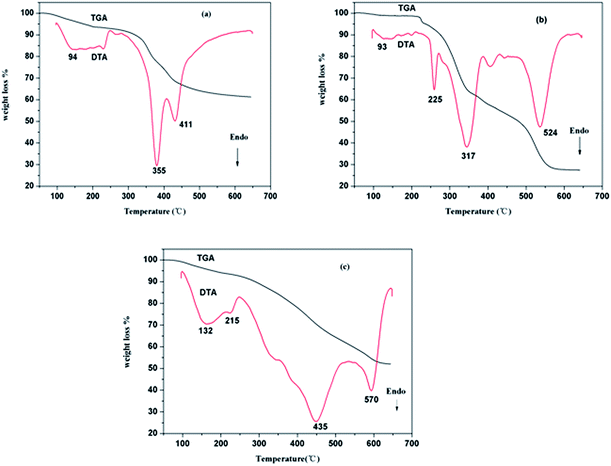 | ||
| Fig. 7 Thermogravimetric analysis–differential thermogravimetric thermograms of (a) Mg/Al–LDHs, (b) Dexa and (c) Dexa–LDHs. | ||
3.7 In vitro drug release behaviour
The release property of Dexa from the Dexa–LDHs composite was investigated in phosphate buffered saline (pH = 7.37) at 37 °C. Drug released from the physical mixture of Dexa and LDHs which was investigated as a control, immediately reach 87% of the total amount after 25 min. The fast drug release may result from weak electrostatic interaction between Dexa molecules and LDHs surface. A slow decline of Dexa was observed with 80% Dexa left in solution after 250 min, which may be attributed to the intercalation of Dexa into LDHs. As to the Dexa–LDHs, a burst release phenomenon at the beginning of the tests was observed. And then Dexa–LDHs show a gradual and slow release pattern, with 92.5% Dexa being released after 480 min (Fig. 8). The early fast drug release (41.2% in the first 10 min) may owe to the Dexa molecules which were absorbed on the LDHs surfaces by weak electrostatic-interaction.33 The two-step and prolonged release behavior played an important role in therapeutic treatments, as the initial fast release rapidly provide a therapeutic dose, and the subsequent sustained release can maintain the therapeutic dose for a long period of time.34 Furthermore, in order to gain more insights into the mechanism of drug release, four kinetic models were employed to fit the measured data (ESI S1†). The corresponding rate constants together with the R2 values obtained from the fittings are summarized in Table 2. It can be seen that the release of Dexa from Dexa–LDHs fits the parabolic diffusion model very well, with the satisfactory coefficients of 0.9763. The simulation results in this study suggest that the release process based on Dexa–LDHs is controlled by the diffusion of Dexa anions from the surface of LDHs particles.| Kinetic model | Kinetic equation | R2 | k | a |
|---|---|---|---|---|
| Zero-order | Mt − M0 = kt + a | 0.67422 | −7.52376 | −1262.321 |
| First-order | ln(Mt/M0) = −kt + a | 0.72908 | 0.00556 | −0.83789 |
| Parabolic diffusion model | (1 − Mt/M0)/t = kt−0.5 + a | 0.97638 | 0.21782 | −0.0152 |
| Modified Freundlich model | 1 − Mt/M0 = kta | 0.92945 | 0.22233 | −1.23943 |
3.8 Dexa–LDHs reduced OVA-induced BAL fluid inflammatory cell recruitment
To evaluate the therapeutic efficacy of Dexa–LDHs in a murine asthma model, rats were immunized and challenged with OVA to obtain the asthmatic models. And then the asthmatic rats were treated with Dexa–LDHs, Dexa and LDHs, respectively (Fig. 9A). The representative characteristic of asthma is the increase of inflammatory cells such as macrophages, eosinophils, neutrophils and lymphocytes.35,36 Therefore, BAL fluid was collected and the population of cells in the BAL fluid was counted. As shown in Fig. 9B, the numbers of eosinophils, neutrophils, and macrophages in the BALF were higher in the OVA exposed group than in the saline group (p < 0.05). Dexa–LDHs treated group more significantly reduced the number of eosinophils, compared to the groups treated with Dexa and those treated with LDHs. Meanwhile, Dexa–LDHs also show better effect than Dexa and LDHs on reducing the number of macrophages and neutrophils in the BAL fluid. This might be because Dexa–LDHs possess the ability of controlled release of Dexa.3.9 Dexa–LDHs reduced OVA-induced BAL fluid Th2 cytokine levels
Th2 lymphocytes play an important role in the initiation and progression of allergic diseases, including asthma, by releasing IL-4, IL-5 and IL-13.37 These cytokines may affect the expression of inflammatory molecules by the endothelial cells of the bronchial circulation and the airway epithelial cells, and may also promote eosinophil and lymphocyte recruitment. Specifically, IL-4 and IL-13 play critical roles in the eosinophil infiltration into lung tissue and stimulate mucus hypersecretion and AHR.38 In the present study, we measured the level of IL-4 and IL-13 in BAL fluid by ELISA. As shown in Fig. 9C and D, OVA challenge resulted in a significant elevation of IL-4 and IL-13 in BALF compared to the saline group. Cytokine elevation was significantly suppressed by the treatments of Dexa and Dexa–LDHs while LDHs itself had little effect on the cytokine elevation. Dexa–LDHs were more effective than Dexa to inhibit the elevation of IL-4 and IL-13 level. The difference between the two groups treated with Dexa and Dexa–LDHs clearly demonstrates that Dexa–LDHs exert strong anti-asthmatic effects on asthmatic rats.3.10 Dexa–LDHs reduced airway hyperresponsiveness in OVA-induced rats asthma
Since airway hyper-responsiveness (AHR) is the hallmark of the physiological changes in asthma model,39 we also evaluated the effects of Dexa–LDHs on AHR in OVA-immunized rats. The clinical parameters of the lung function in response to the increasing concentration of methacholine were measured. As shown in Fig. 10, all the OVA-challenged rats show that bronchial AHR with the methacholine concentration. The airway response to methacholine in OVA-treated group was much higher than normal saline treated group (P < 0.01 at 100 and 330 μg kg−1 methacholine). However, the treatment of both Dexa and Dexa–LDHs can significantly inhibit AHR and the inhibitive effect become more and more obvious as the methacholine concentration increases (Fig. 10). Comparatively, Dexa–LDHs have a better inhibitive effect than Dexa on the AHR. These findings clearly indicate that the intercalation of Dexa into LDHs can enhance the inhibitive effect of Dexa on bronchia AHR of asthmatic rats.3.11 Dexa–LDHs effects on OVA-induced histopathological changes in lung
The most direct indicator of airway inflammation was lung histopathology.40 To further observe the effects of Dexa–LDHs on lung tissues in OVA-induced asthma rats, lung sections were stained with H&E. As shown in Fig. 11A, the lung tissues from saline-treated rats show normal structural architecture with few inflammatory cell infiltration around bronchiole and intralumen, whereas the OVA-sensitized and challenged rats show a larger number of inflammatory cells, including eosinophils and mononuclear cells, in peribronchial and perivascular spaces (Fig. 11B). The treatment of Dexa–LDHs is more effective than Dexa in the inhibition of the peribronchial infiltration of inflammatory cells (Fig. 11C and D). In addition, OVA-challenged rats showed more obvious airway wall thickness compared with the saline group, and treatment of Dexa–LDHs could obviously alleviate this airway wall thickness.Rats treated with Dexa–LDHs show a better therapeutic efficacy compared to Dexa alone treatment, which might be attributed to the following reasons: (1) encapsulation of Dexa into LDHs enhance the bioavailability of Dexa and exert a profound influence on the pharmacokinetics of the drug; (2) encapsulation of Dexa into LDHs resulted in higher accumulation of Dexa in lung so that more drugs reached the inflamed tissue to exert their therapeutic effect.
4 Conclusions
In this study, we have synthesized Dexa–LDHs by coprecipitation method. The successful intercalation of Dexa into LDHs was confirmed by X-ray and FTIR analysis. Elemental C/H/N and inductive coupled plasma (ICP) analysis indicated that the compositions of the nanohybrids. The thermal stability of Dexa anions was enhanced by holding together with LDHs layers. Dexa–LDHs nanoparticles exhibit the sustained release of Dexa in vitro. The in vivo asthma rat models were established by the stimulation of OVA. The in vivo anti-asthma studies showed that Dexa–LDHs can significantly enhance the inhibitive effect of Dexa on the inflammatory response. Compared with other groups treated with Dexa and LDHs, the treatment of Dexa–LDHs is more effective to reduce the number of inflammatory cells such as macrophages, eosinophils and neutrophils in the BAL fluid and lung tissue sections. In addition, the use of Dexa–LDHs significantly reduced the bronchial hyperresponsiveness of asthmatic mice. In conclusion, LDHs could be a promising candidate in the design and tailoring of novel pulmonary drug delivery systems.Acknowledgements
This work was financially supported by the International S&T Cooperation Program of China, (Grant no. 0102011DFA32980), the National Natural Science Foundation of China (Grant no. 81301310, 81201599, 81271694, 81301157), the Science and Technology Commission of Shanghai Municipality (Grant no. 11411951500 and 12nm0502200).Notes and references
- I. M. Adcock, G. Caramori and K. F. Chung, Lancet, 2008, 372, 1073–1087 CrossRef CAS.
- S. T. Holgate, Mol. Biotechnol., 2002, 22, 179–189 CrossRef CAS PubMed.
- R. Polosa and J. Morjaria, Respir. Med., 2008, 102, 1499–1510 CrossRef PubMed.
- Y. Matsuo, T. Ishihara, J. Ishizaki, K. Miyamoto, M. Higaki and N. Yamashita, Cell. Immunol., 2009, 260, 33–38 CrossRef CAS PubMed.
- J. Varshosaz, J. Emami, N. Trvakoli, A. Fassihi, M. Minaiyan, F. Ahmadi and F. Dorkoosh, Int. J. Pharm., 2009, 365, 69–76 CrossRef CAS PubMed.
- R. K. Kumar, C. Herbert, P. S. Thomas, L. Wollin, R. Beume, M. Yang, D. C. Webb and P. S. Foster, J. Pharmacol. Exp. Ther., 2003, 30, 349–355 CrossRef PubMed.
- R. Dahl, Respir. Med., 2006, 100, 1307–1317 CrossRef PubMed.
- N. J. Kenyon, J. M. Bratt, J. Lee, J. Luo, L. M. Franzi, A. A. Zeki and K. S. Lam, PLoS One, 2013, 8, e777730 Search PubMed.
- Z. P. Xu, M. Nieber, K. Porazik, T. L. Walker, H. M. Cooper, A. P. Middelberg, P. P. Gray, P. F. Bartlett and G. Q. Lu, J. Controlled Release, 2008, 130, 86–94 CrossRef CAS PubMed.
- J.-H. Choy, J.-S. Jung, J.-M. Oh, M. Park, J. Jeong, Y.-K. Kang and O.-J. Han, Biomaterials, 2004, 25, 3059–3064 CrossRef CAS PubMed.
- L. L. Qin, M. Xue, W. R. Wang, R. R. Zhu, S. L. Wang, J. Sun, R. Zhang and X. Y. Sun, Int. J. Pharm., 2010, 388, 223–230 CrossRef CAS PubMed.
- Z. Gu, B. E. Rolfe, A. C. Thomas, J. H. Campbell, G. Q. Lu and Z. P. Xu, Biomaterials, 2011, 32, 7234–7240 CrossRef CAS PubMed.
- S.-J. Won and J.-H. Choy, Inorg. Chem., 2003, 42, 8134–8136 CrossRef PubMed.
- S. P. Lonkar, A. Leuteritza and G. Heinrichab, RSC Adv., 2013, 3, 1495–1501 RSC.
- Y. Kameshima, H. Yoshizaki, A. Nakajima and K. Okada, J. Colloid Interface Sci., 2006, 298, 624–628 CrossRef CAS PubMed.
- S.-J. Choi, J.-M. Oh and J.-H. Choy, J. Phys. Chem. Solids, 2008, 69, 1528–1532 CrossRef CAS PubMed.
- F. Cao, Y. J. Wang, Q. E. Ping and Z. J. Liao, Int. J. Pharm., 2011, 404, 250–256 CrossRef CAS PubMed.
- Z. P. Xu, T. L. Walker, K. L. Liu, H. M. Cooper, G. Q. Lu and P. F. Bartlett, Int. J. Nanomed., 2007, 2, 163–174 CAS.
- K. M. Tyner, S. R. Schiffman and E. P. Gianneli, J. Controlled Release, 2004, 95, 501–514 CrossRef CAS PubMed.
- Y. Y. Wong, H. M. Copper, G. K. Zhan, M. Chen, P. Bartlett and Z. P. Xu, J. Colloid Interface Sci., 2012, 369, 453–459 CrossRef CAS PubMed.
- L. L. Qin, M. Wang, R. R. Zhu, S. H. You, P. Zhou and S. L. Wang, Int. J. Nanomed., 2013, 8, 2053–2064 CrossRef PubMed.
- A. Li, L. L. Qin, W. R. Wang, R. R. Zhu, Y. C. Yu, H. Liu and S. L. Wang, Biomaterials, 2011, 32, 469–477 CrossRef CAS PubMed.
- V. Rives, Layered Double Hydroxides: Present and Future, NovaScience Publishers, New York, 2001 Search PubMed.
- J. H. Yang, Y. S. Han, M. Park, T. H. Park, S. J. Wang and J. H. Choy, Chem. Mater., 2007, 19, 2679 CrossRef CAS.
- L. M. Yin, H. Y. Li and Q. H. Zhang, Biochem. Biophys. Res. Commun., 2010, 398, 547–552 CrossRef CAS PubMed.
- G. Q. Wu, L. Y. Wang, D. G. Evans and X. Duan, Eur. J. Inorg. Chem., 2006, 16, 3185 CrossRef.
- Z. P. Xu, N. D. Kurniawan, P. F. Bartlett and G. Q. Lu, Chem.–Eur. J., 2007, 13, 2824 CrossRef CAS PubMed.
- F. Cavani, F. Trifirò and A. Vaccari, Catal. Today, 2001, 11, 173 CrossRef.
- J. Chakraborty, S. Roychowdhury, S. Sengupta and S. Ghosh, Mater. Sci. Eng., C, 2013, 33, 2168–2174 CrossRef CAS PubMed.
- Z. P. Xu and H. C. Zeng, J. Phys. Chem. B, 2001, 105, 1743 CrossRef CAS.
- Z. P. Xu, S. K. Saha, P. S. Braterman and D. Souza, Polym. Degrad. Stab., 2006, 91, 3237 CrossRef CAS PubMed.
- P. K. Sahoo, H. S. Panda and D. Bahadur, Mater. Chem. Phys., 2013, 142, 106–112 CrossRef CAS PubMed.
- R. Xiao, W. R. Wang, L. L. Pan, R. R. Zhu, Y. C. Yu, H. P. Li, H. Liu and S. L. Wang, J. Mater. Sci., 2011, 46, 2635–2643 CrossRef CAS.
- L. Yan, W. Chen, X. Y. Zhu, L. B. Huang, Z. G. Wang, G. Y. Zhu, V. A. L. Roy, K. N. Yua and X. F. Chen, Chem. Commun., 2013, 49, 10938–10940 RSC.
- Y. J. Oh, J. W. Lee, J. Y. Seo, T. Y. Rhim, S.-H. Kim, H. J. Yoon and K. Y. Lee, J. Controlled Release, 2011, 150, 56–62 CrossRef CAS PubMed.
- X. J. Xiao, X. W. Zeng, X. X. Zhang, L. Ma, X. Y. Liu, H. Q. Yu, L. Mei and Z. G. Liu, Int. J. Nanomed., 2013, 8, 4553–4562 Search PubMed.
- H. J. Park, C. M. Lee and I. D. Jung, Int. Immunopharmacol., 2009, 9, 261–267 CrossRef CAS PubMed.
- W. R. Wang, R. R. Zhu, Q. Xie, A. Li, Y. Xiao, K. Li, H. Liu, D. X. Cui, Y. H. Chen and S. L. Wang, Int. J. Nanomed., 2012, 7, 3667–3677 CrossRef CAS PubMed.
- J. Q. Li, L. Li, X. D. Liu, R. Li and X. Yang, RSC Adv., 2013, 3, 25388–25395 RSC.
- X. Wang, W. Xu and S. Mohapatra, Genet. Vaccines Ther., 2008, 6, 1–9 CrossRef PubMed.
Footnotes |
| † Electronic supplementary information (ESI) available. See DOI: 10.1039/c4ra09977j |
| ‡ Both authors contributed equally to this work. |
| This journal is © The Royal Society of Chemistry 2015 |


